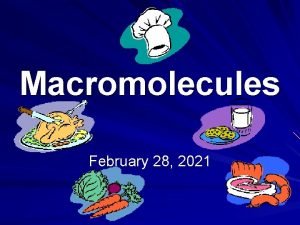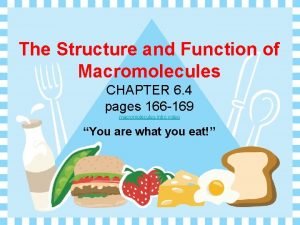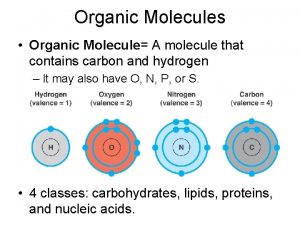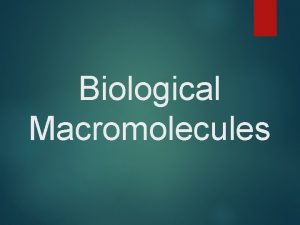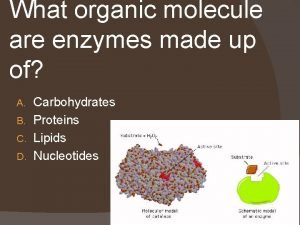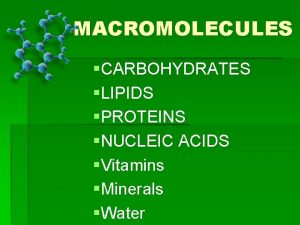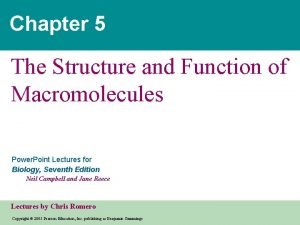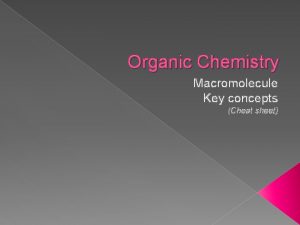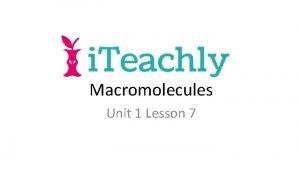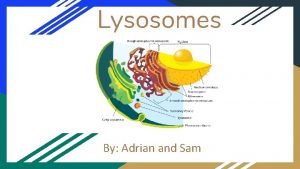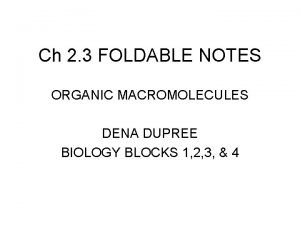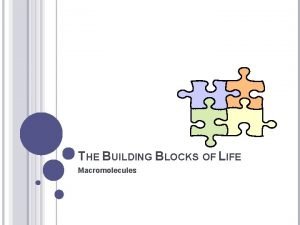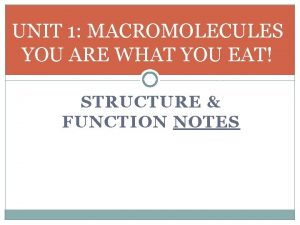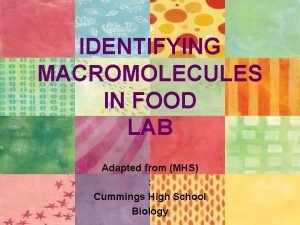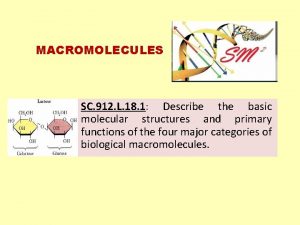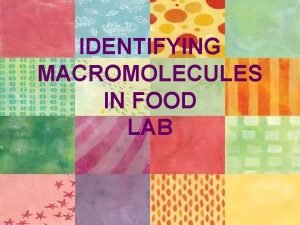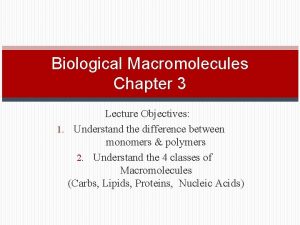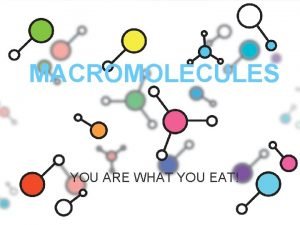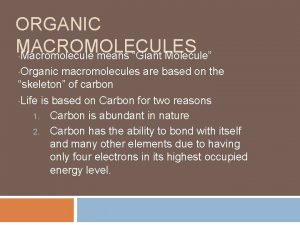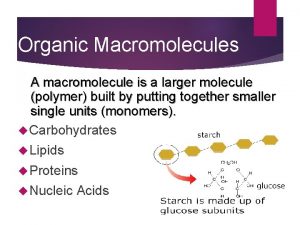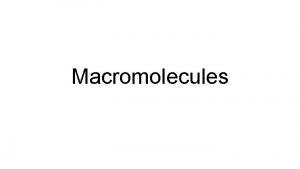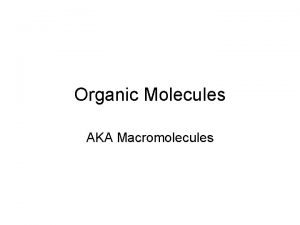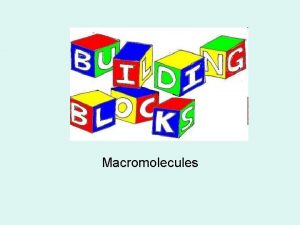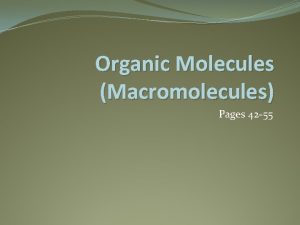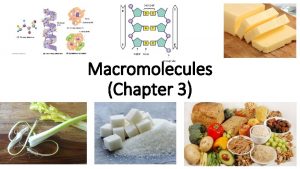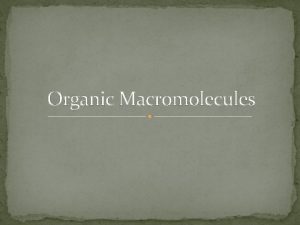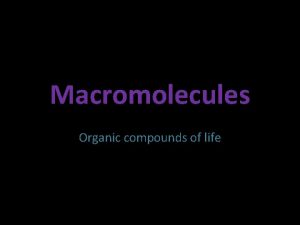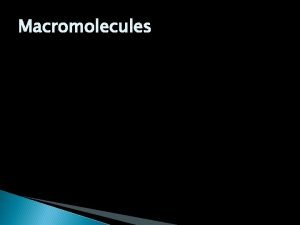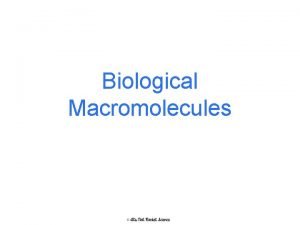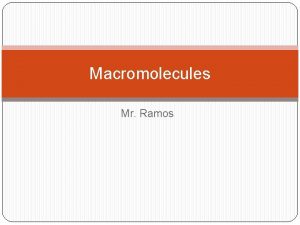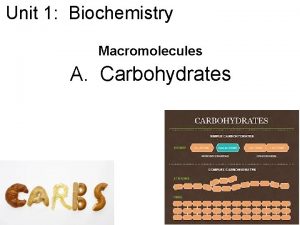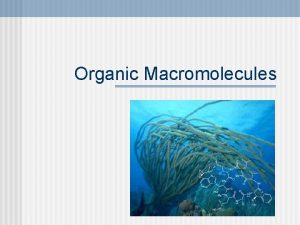Organic Macromolecules A macromolecule is a larger molecule



















- Slides: 19

Organic Macromolecules A macromolecule is a larger molecule (polymer) built by putting together smaller single units (monomers). Always contain Carbon, so commonly called Carbon Compounds

4 Types of Organic Molecules Carbohydrates Lipids Proteins Nucleic Acids

CARBOHYDRATES Monomer - Monosaccharides (Mono = 1) Are major sources of energy for cells Ex. Glucose – cellular respiration Most common monosaccharides: glucose, fructose, galactose

Disaccharide – two monosaccharides bonded together. table sugar (sucrose) is made up of glucose and fructose bonded together milk sugar (lactose) is made up of glucose and galactose

Polysaccharide – more than two monosaccharide bonded together. STARCH - made by plants, broken down by plants and animals CELLULOSE - made by plants GLYCOGEN - made and stored by animals only. *Glycogen is stored in the liver and the muscles and provides the body with a readily available source of energy if blood glucose levels decrease.

Carbohydrates - FUNCTION Main source of immediate energy for living things Plants and some animals use carbohydrates for structural purposes Sugar or Starch

ELEMENTS that make up CARBOHYDRATES Made up of elements C, H, and O (carbon, hydrogen, and oxygen) Ratio 1: 2: 1


Lipid - MONOMER Lipid monomers are made up of 3 fatty acids and a glycerol (Triglycerides)

Lipids (fats and oils) - FUNCTION Used Some to store energy lipids are important parts of biological membranes and waterproof coverings & insulation.

Lipids – ELEMENTS Contains Many C, H, and O. more H then O or C.

Saturated fat Unsaturated fat (solid at room temp) (liquid at room temp) Fats, Waxes, Oils, Steroids Wax covers the feathers of some aquatic birds and the leaf surfaces of some plants, where its hydrophobic (water-repelling) properties prevent water from sticking to, or soaking into, the surface. This is why water beads up on the leaves of many plants, and why birds don’t get soaked through when it rains.

Amino Acid are linked together by peptide bonds (Monomer for Protein) Contain an amino end (NH 2 and a carboxyl end (COOH) 20 different amino acids are commonly found in proteins

Proteins Contain ELEMENTS - C, H, O, N, and some have S. FUNCTION: Control Used the rate of reactions. (enzymes are proteins) to form bones and muscles Transport substances into or out of cells or help to fight disease

Protein SOURCES 1) MEAT 2) BEANS 3) NUTS 4) EGGS

Nucleic Acids Monomer is the nucleotide Consist of 3 parts 5 -carbon A sugar phosphate group Nitrogenous base

Nucleic Acids DNA Contains the elements C, H, O, N, and P FUNCTION: Store and transmit hereditary or genetic information

NUCLEIC ACID - EXAMPLES RNA- ribonucleic acid DNAdeoxyribonucleic acid

Carbon Macromolecules Compounds include Carbohydrates Lipids Nucleic acids that consist of Fats and oils Nucleotides Amino Acids Sugars and starches which contain Carbon, hydrogen, oxygen Proteins which contain Carbon, hydrogen, oxygen, nitrogen, phosphorus Carbon, hydrogen, oxygen, nitrogen,
 Atom molecule macromolecule organelle cell
Atom molecule macromolecule organelle cell Organic macromolecules chart
Organic macromolecules chart What is this?
What is this? Whats an organic molecule
Whats an organic molecule Whats macromolecules
Whats macromolecules Enzymes are composed of what organic molecule
Enzymes are composed of what organic molecule Site:slidetodoc.com
Site:slidetodoc.com Chapter 5 the structure and function of macromolecules
Chapter 5 the structure and function of macromolecules Organic chemistry cheat sheet
Organic chemistry cheat sheet Macromolecules poem
Macromolecules poem Macromolecules
Macromolecules Lysosomes
Lysosomes Macromolecules foldable
Macromolecules foldable Macromolecules
Macromolecules Macromolecules you are what you eat
Macromolecules you are what you eat Iki indicator
Iki indicator Monosacharride
Monosacharride Macromolecules in food lab
Macromolecules in food lab Pizza macromolecules
Pizza macromolecules You are what you eat macromolecules
You are what you eat macromolecules

